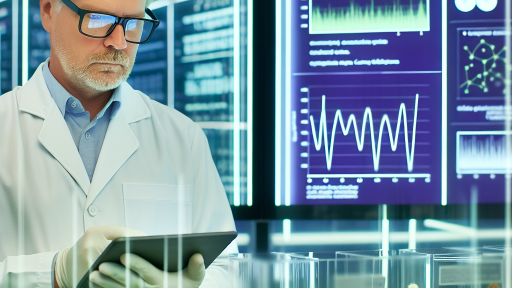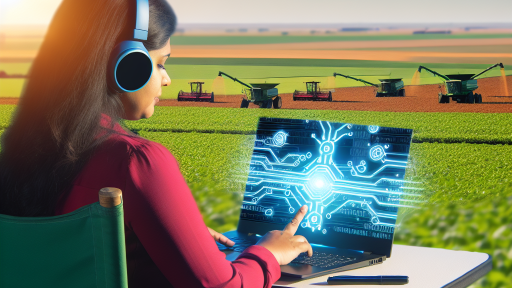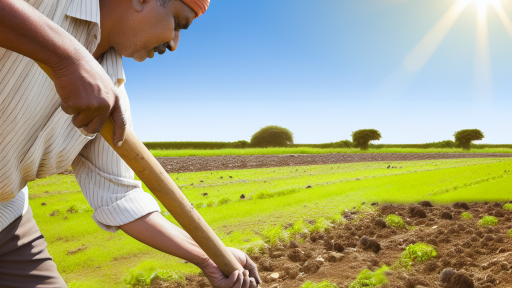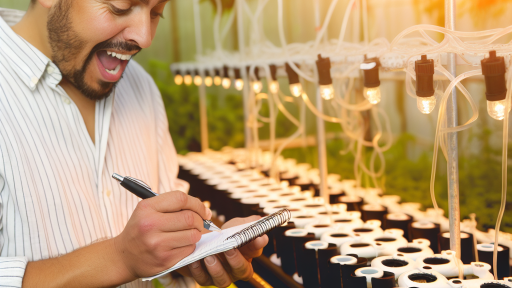Understanding Aquaponics: A Brief Overview
What is Aquaponics?
Aquaponics combines aquaculture and hydroponics.
This sustainable farming method grows fish and plants together.
Fish waste provides nutrients for the plants.
In turn, the plants purify the water for the fish.
The Benefits of Aquaponics
Aquaponics offers numerous environmental benefits.
It uses significantly less water compared to traditional farming.
The system minimizes agricultural runoff.
Furthermore, it eliminates the need for chemical fertilizers.
Components of an Aquaponic System
An aquaponic system consists of several key components.
It includes fish tanks, grow beds, and plumbing systems.
Each component plays a vital role in maintaining balance.
Fish Tanks
Fish tanks house the aquatic animals in the system.
Common fish choices include tilapia, trout, and catfish.
Grow Beds
Grow beds are where plants thrive in the aquaponic system.
Plants can range from leafy greens to fruit-bearing crops.
Transform Your Agribusiness
Unlock your farm's potential with expert advice tailored to your needs. Get actionable steps that drive real results.
Get StartedPlumbing Systems
Plumbing systems circulate water between fish tanks and grow beds.
Effective plumbing ensures proper nutrient flow and aeration.
Types of Aquaponic Systems
Aquaponic systems can vary widely in design.
Common types include flooded, media-based, and vertical systems.
Flooded Systems
Flooded systems utilize a simple paradigm.
Water fills and drains from grow beds on a regular cycle.
Media-Based Systems
Media-based systems rely on a solid substrate for plants.
This allows roots to absorb nutrients while filtering water.
Vertical Systems
Vertical systems maximize space efficiency.
They enable growers to produce food in urban settings.
Environmental Considerations
Environmental control is crucial for aquaponic operations.
Factors include temperature, light, and pH levels.
Each factor influences plant growth and fish health.
Temperature Control
Fish and plants have specific temperature requirements.
Monitoring and adjustments help maintain optimal conditions.
Light Management
Light plays a crucial role in plant growth.
Using artificial lights can supplement natural sunlight.
pH Level Regulation
The pH level of water affects nutrient availability.
Regular testing ensures balance for fish and plants.
Aquaponics as a Path to Sustainable Agriculture
Aquaponics represents a promising approach to sustainable agriculture.
It fosters ecological balance while meeting food demands.
As technology evolves, its benefits will become even more accessible.
The Importance of Climate Control in Aquaponic Systems
Understanding Climate Control
Climate control is essential in aquaponic operations.
This process regulates temperature, humidity, and light levels.
Showcase Your Farming Business
Publish your professional farming services profile on our blog for a one-time fee of $200 and reach a dedicated audience of farmers and agribusiness owners.
Publish Your ProfileEach of these elements significantly impacts plant growth and fish health.
Benefits of Effective Climate Management
Effective climate management increases crop yields.
It helps maintain optimal conditions for fish services.
Moreover, it reduces stress on both plants and fish.
As a result, the system can operate efficiently.
Temperature Regulation
Temperature affects both plant growth and fish survival.
Excessive heat can lead to crop loss and fish death.
Conversely, low temperatures hinder growth rates.
Maintaining a consistent temperature enhances system stability.
Use heating or cooling systems as necessary to achieve this.
Humidity Control
Humidity plays a crucial role in aquaponics.
High humidity can promote mold growth and diseases.
On the other hand, low humidity can stress plants.
Employ dehumidifiers and misting systems to regulate moisture.
Lighting Optimization
Plants require specific light conditions for photosynthesis.
Natural sunlight varies throughout the year and can be insufficient.
Artificial lighting can supplement natural light effectively.
Adjust light intensity and duration based on plant needs.
Monitoring Systems
Modern technology enhances climate control efforts.
Automated monitoring systems track various environmental parameters.
Real-time data enables adjustments for optimal conditions.
Invest in sensors and control systems for better management.
Improving Aquaponic Outcomes
Effective climate control is vital for a successful aquaponic system.
It ensures healthy plants and fish, leading to better productivity.
Implementing these strategies can significantly improve outcomes.
Key Climate Variables Affecting Aquaponics
Temperature
Temperature plays a crucial role in aquaponic systems.
Both fish and plants thrive within specific temperature ranges.
Monitoring water temperature ensures fish health.
For example, tilapia prefer temperatures between 75°F and 86°F.
Plants, on the other hand, generally prefer cooler conditions.
Maintaining the right balance is essential for optimal growth.
Heating systems may be necessary during colder months.
Conversely, cooling systems help during hot periods.
Temperature fluctuations can stress both plants and fish.
Using thermoregulation techniques can mitigate this stress.
Humidity
Humidity directly impacts plant transpiration rates.
High humidity can lead to mold and disease issues.
Conversely, low humidity stresses plants and decreases growth.
Maintaining a relative humidity of around 50-70% is ideal.
Using dehumidifiers can help control excessive moisture.
Showcase Your Farming Business
Publish your professional farming services profile on our blog for a one-time fee of $200 and reach a dedicated audience of farmers and agribusiness owners.
Publish Your ProfileIncreasing ventilation can also regulate humidity levels.
Maintaining proper humidity fosters a healthy growth environment.
Monitoring humidity requires continuous assessment.
Utilizing hygrometers aids in humidity tracking.
Light
Light is vital for photosynthesis in aquaponic plants.
Plants need adequate light to grow efficiently.
Natural sunlight is beneficial but may not be sufficient.
Supplementing with artificial lights optimizes growth rates.
LED lights are preferred for their energy efficiency.
Different plants have varying light requirements.
Understanding these needs helps in planning layouts.
Light duration impacts flower and fruit development.
Using timers allows for consistent light schedules.
Ultimately, proper light management enhances yield quality.
Delve into the Subject: Comparing Hydroponics and Aquaponics
Methods for Regulating Temperature in Aquaponics
Understanding Temperature Regulation
Temperature regulation is essential in aquaponic systems.
It ensures optimal growth conditions for both plants and fish.
A proper range improves efficiency and yield.
Thermal Management Techniques
Several methods exist to manage temperature effectively.
Implementing these strategies can greatly benefit your setup.
Use of Greenhouses
Greenhouses offer a controlled environment for aquaponics.
They trap heat during the day, reducing heating costs.
Additionally, greenhouses can provide shading to avoid overheating.
Heat Pumps
Heat pumps are an efficient way to control temperature.
They can heat or cool the water as needed.
Consider installing a heat pump in your system for flexibility.
Insulation
Proper insulation minimizes heat loss in aquaponic systems.
Using insulating materials on walls and tanks is beneficial.
This technique reduces energy costs and maintains stable temperatures.
Water Temperature Monitoring
Regular monitoring of water temperature is crucial.
Utilize digital thermometers for accurate readings.
Keeping track of temperature helps optimize fish and plant health.
Ventilation Strategies
Proper ventilation influences temperature control.
Consider using fans or vents to regulate airflow.
This approach can help in cooling down the environment during hot weather.
Shading Options
Utilizing shading cloths can effectively reduce heat inside a grow space.
This method prevents direct sunlight from raising temperatures excessively.
Additionally, strategic placement of trees can provide natural shade.
Energy Efficiency Practices
Implement energy-efficient practices to manage costs.
LED grow lights can reduce heat output while still providing light.
Showcase Your Farming Business
Publish your professional farming services profile on our blog for a one-time fee of $200 and reach a dedicated audience of farmers and agribusiness owners.
Publish Your ProfileIncorporating timers can help in optimizing energy usage throughout the day.
Balancing Temperature for Optimal Aquaponic Growth
All these methods combined can create a balanced aquaponics system.
Balancing temperature enhances productivity and sustainability.
Thus, proper temperature management ensures a thriving aquaponic environment.
Find Out More: Managing Soil pH for Optimal Crop Growth
Humidity Management Techniques in Aquaponic Operations
Understanding Humidity Control
Humidity control is crucial in aquaponic systems.
Proper humidity levels enhance plant growth and aquatic life.
Excessive humidity can lead to mold and disease.
Conversely, low humidity can stress plants and fish.
Choosing the Right Equipment
Selecting appropriate equipment helps maintain optimal humidity.
Dehumidifiers are effective in reducing excess moisture.
Humidifiers can add moisture back when levels drop.
Monitoring devices provide real-time humidity data.
Invest in reliable sensors for accurate readings.
Natural Ventilation Techniques
Natural ventilation helps regulate humidity levels effectively.
Open windows and vents allow air exchange.
Strategically placed fans can enhance airflow.
Proper ventilation reduces accumulated moisture.
Consider the building’s design to optimize airflow.
Using Water Features Wisely
Water features can influence humidity levels in aquaponics.
Fish tanks and plant beds release moisture into the air.
Balance tank size to avoid excess humidity.
Monitor evaporation rates regularly for adjustments.
Implementing Plant Selection Strategies
Choosing humidity-tolerant plants can improve system resilience.
Some plants thrive in high humidity environments.
Research suitable species for your aquaponic system.
Diversity in plant selection can stabilize humidity levels.
Routine Monitoring and Adjustment
Regular checks on humidity levels ensure optimal conditions.
Adjust humidity strategies based on seasonal changes.
Keep a log of humidity changes for analysis.
Adapt techniques as needed for evolving conditions.
Gain More Insights: Using Satellite Imagery For Precision Farming
The Role of Lighting in Climate Control for Aquaponics
Understanding Lighting’s Importance
Lighting plays a vital role in aquaponic systems.
It influences plant growth and fish health significantly.
Moreover, the right lighting can control temperature levels.
This aspect is essential for optimizing yield.
Types of Lighting Used in Aquaponics
Diverse lighting types are used in aquaponic operations.
LED lights are popular due to their energy efficiency.
They provide adjustable light spectrums for various plants.
Fluorescent lights are another common option.
Showcase Your Farming Business
Publish your professional farming services profile on our blog for a one-time fee of $200 and reach a dedicated audience of farmers and agribusiness owners.
Publish Your ProfileThey emit a wider spectrum, promoting growth in seedlings.
How Light Affects Plant Growth
Light directly influences photosynthesis rates in plants.
Higher light intensity can lead to faster growth rates.
Additionally, the duration of light exposure is crucial.
Plants require specific light cycles to thrive.
Managing Light for Optimal Conditions
Consistent monitoring of light conditions is essential.
Adjustments may be needed based on seasonal changes.
Using light timers can automate these processes effectively.
Furthermore, combining natural and artificial light can enhance growth.
Impact of Lighting on Fish Health
Lighting affects fish behavior and health in aquaponics.
It can influence feeding patterns and breeding habits.
Appropriate light levels can reduce stress in fish populations.
Indirectly, this improves fish quality and yield.
Integrating Lighting and Climate Control
Integrating proper lighting strategies is key for success.
It enhances both plant and fish productivity.
Therefore, investing in a well-planned lighting system pays off.
Learn More: Machine Learning Applications In Crop Management
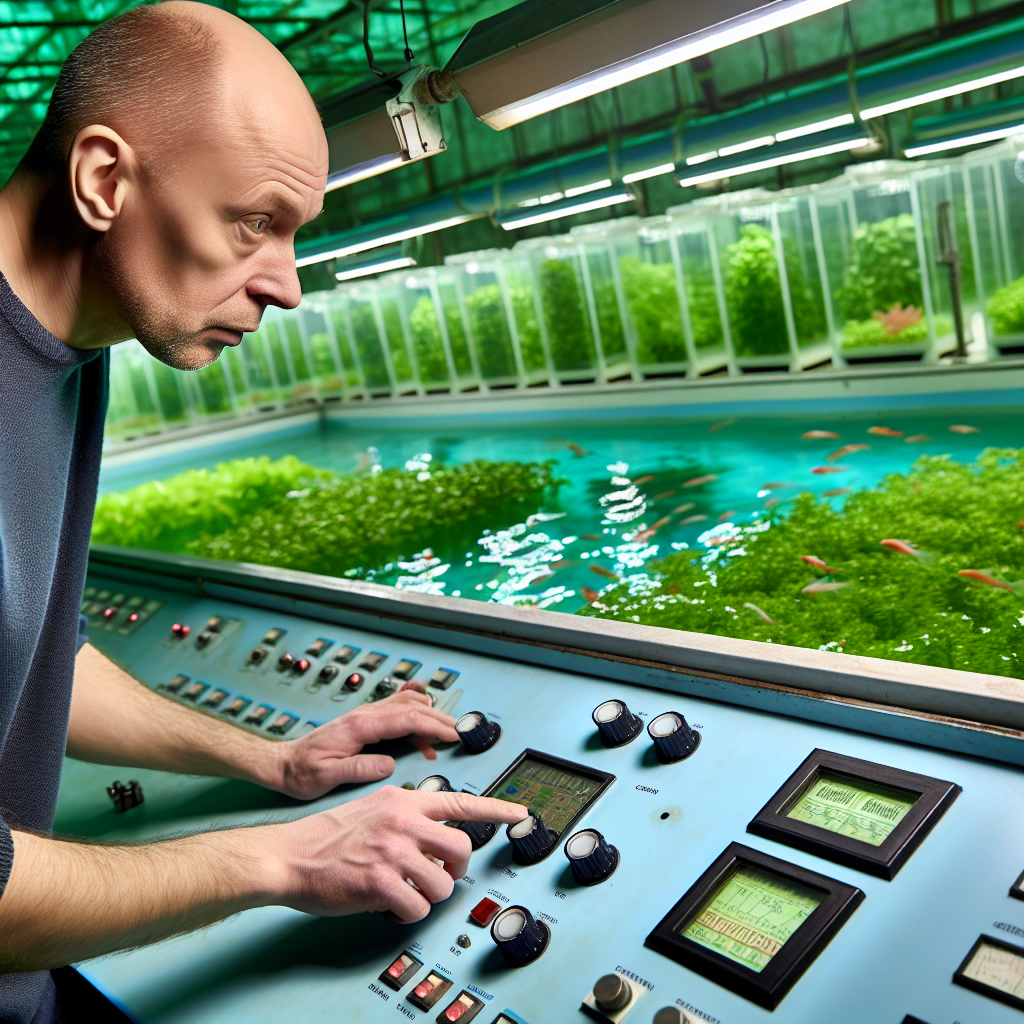
Climate Control Technologies
Sensors
Sensors play a vital role in aquaponics operations.
They monitor environmental parameters continuously.
Parameters include temperature, humidity, and light levels.
Various types of sensors are available for use.
For instance, temperature sensors ensure optimal conditions.
Humidity sensors help maintain moisture levels in the air.
Light sensors track sunlight intensity for plant growth.
Data from sensors allows for informed decision-making.
Regular maintenance of sensors is crucial for accuracy.
Controllers
Controllers manage the information received from sensors.
They process data and adjust environmental conditions accordingly.
This technology helps maintain target conditions effectively.
For example, controllers can activate fans when needed.
Moreover, they may control heating systems for temperature regulation.
Some models allow for remote operation via mobile apps.
This feature enhances convenience and accessibility.
Investing in quality controllers can yield better crop yields.
Automation
Automation streamlines aquaponic operations significantly.
Automation technology can reduce labor costs and improve efficiency.
Automated systems can monitor and adjust multiple factors simultaneously.
This includes controlling lights, pumps, and nutrient delivery.
With automation, farmers experience less stress managing tasks.
Additionally, they can focus on strategic growth initiatives.
Showcase Your Farming Business
Publish your professional farming services profile on our blog for a one-time fee of $200 and reach a dedicated audience of farmers and agribusiness owners.
Publish Your ProfileSome systems offer data analytics to improve operation strategies.
Integrating automation can lead to greater sustainability in farming.
Combining Technologies
Integrating sensors, controllers, and automation maximizes effectiveness.
This combination creates a responsive environment for plants and fish.
Consequently, it allows for precise control over growth conditions.
Such integration fosters resource efficiency and higher productivity.
Ultimately, it enhances the success of aquaponic systems.
Best Practices for Monitoring and Adjusting Aquaponic Climate Conditions
Utilizing Climate Control Systems
Implement a climate control system for optimal plant and fish growth.
This system should manage temperature, humidity, and light exposure.
Choose an automated solution for consistent monitoring and adjustments.
Consider smart technology that integrates with your aquaponics setup.
Regular Monitoring of Environmental Parameters
Continuously monitor key environmental parameters in your aquaponic system.
Use sensors to track temperature, moisture, pH levels, and nutrient concentrations.
Establish threshold levels for each parameter to ensure health and growth.
Record data regularly to identify trends and optimize conditions.
Maintaining Optimal Temperature Conditions
Ensure water temperatures remain stable for fish and plants.
Adjust heating or cooling systems based on real-time data.
For instance, use heaters in cooler months and fans during hotter periods.
Furthermore, insulate growing areas to prevent temperature fluctuations.
Managing Humidity Levels
Control humidity levels to create a comfortable environment.
Install dehumidifiers if moisture levels exceed preferred thresholds.
Conversely, humidifiers can be beneficial in dry conditions.
Regularly assess ventilation to promote air circulation within the system.
Efficient Light Management
Control light exposure for both plants and fish in your setup.
Utilize grow lights if natural sunlight is insufficient.
Set timers to ensure plants receive adequate light duration for photosynthesis.
Adjust light intensity based on plant species and growth stages.
Regular Maintenance of Equipment
Perform routine checks on all climate control equipment.
Clean filters on HVAC units to ensure efficient operation.
Calibrate sensors periodically to maintain accurate readings.
Replace defective equipment promptly to avoid disruptions.
Adjusting Based on Seasonal Changes
Be prepared to adjust your climate settings with seasonal changes.
Monitor how changing temperature and humidity affect your systems.
Adapt your strategies for winter heating and summer cooling.
Furthermore, observe how seasonal trends influence fish and plant health.
Case Studies: Successful Climate Control Strategies in Aquaponics
Introduction to Climate Control in Aquaponics
Climate control significantly influences aquaponic productivity.
Efficient systems create optimal conditions for plants and fish.
Through case studies, we explore successful strategies in this field.
Aquaponics at GreenSprout Farms
GreenSprout Farms implemented an advanced climate control system.
They used a combination of sensors, software, and automation.
Showcase Your Farming Business
Publish your professional farming services profile on our blog for a one-time fee of $200 and reach a dedicated audience of farmers and agribusiness owners.
Publish Your ProfileThis approach allowed precise monitoring of temperature and humidity.
As a result, crop yields increased by 30% over two years.
Key Features of Their System
- Real-time data collection from multiple environmental sensors.
- Automated adjustments to heating and cooling systems.
- Integration of weather forecasts for predictive adjustments.
Enviroponics: A Sustainable Approach
Enviroponics adopted a unique sustainable method for climate control.
They focus on passive solar energy systems for heating.
This strategy reduces dependence on traditional energy sources.
Consequently, they achieved a 40% reduction in energy costs.
Innovative Technology Utilized
- Thermal mass techniques to regulate temperature.
- Greenhouse designs that maximize sunlight exposure.
- Rainwater harvesting for irrigation needs.
Urban AquaFarm: Maximizing Urban Space
Urban AquaFarm addressed climate control challenges in confined spaces.
They utilized vertical farming techniques within a controlled environment.
Their system features LED grow lights and efficient airflow management.
As a result, they produce high-quality crops year-round.
Specific Strategies Employed
- Customizable light spectrum settings for different growth stages.
- Advanced fans for uniform air circulation.
- Hydronic heating systems to maintain optimal temperatures.
Innovations in Sustainable Farming Technologies
These case studies highlight diverse strategies for climate control.
Through innovation and technology, aquaponics operations can thrive.
Ultimately, efficient climate management fosters sustainability in agriculture.

